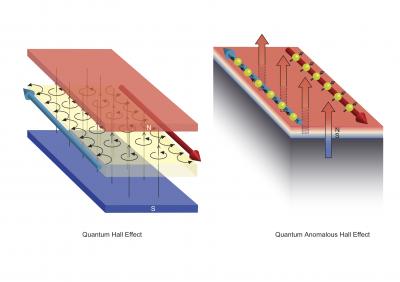Scientists Pave Way to Dissipationless Semiconductors
Researchers at RIKEN and the University of Tokyo claim that the there may be a way to build semiconductors that do not leak any power at all.
While it is key in today's semiconductor research to contain leaking current, researchers said that a switch to a more exotic semiconductor, a magnetic topological insulator, can achieve the goal of ultimate power efficiency, at least as far as power supply is concerned.
Their work is based on a finding from 1980, the quantum Hall effect, which can facilitate dissipationless electricity channels, if magnets 100,000 times stronger than the earth's magnetic field help channel the stream of electrons. Instead of relying on such massive magnets, the scientists discovered that they can use a material's own magnetic properties to achieve the same result. The researchers say the Dirac fermions of the magnetic topological insulator interact with magnetic ions, transporting current and behaving as if they have zero mass and enabling the transfer of current without leaking current. Prototype devices that prove the theory have been created by the team.
Of course, it's not a free lunch, either. The transistors only work in "cryogenic" conditions, but there is hope that the temperature requirement can be softened to take these transistors into the commercial market.
Contact Us for News Tips, Corrections and Feedback
Get Tom's Hardware's best news and in-depth reviews, straight to your inbox.

Wolfgang Gruener is an experienced professional in digital strategy and content, specializing in web strategy, content architecture, user experience, and applying AI in content operations within the insurtech industry. His previous roles include Director, Digital Strategy and Content Experience at American Eagle, Managing Editor at TG Daily, and contributing to publications like Tom's Guide and Tom's Hardware.
-
ricardok ReplyThe transistors only work in "cryogenic" conditions
Err.. Isn't that a superconductor?? -
face-plants Same problem as the super-conducting materials that have shown so many amazing abilities. They can conduct electricity with ZERO resistance, levitate objects indefinitely, and even repel sharks! Now they have to figure out ways to make these materials work without having to bathe them in liquid nitrogen.Reply -
zeratul600 why will i bother if something generates heat or not if it is already near the absolute zero xDXDXD it will be cold anyway! LoL im such and ignorant bastardReply -
alidan ricardokErr.. Isn't that a superconductor??its different, at least from what i remember... cryogenic is cold, but for super conductors, they use liquid helium... or i'm thinking of something else.... which i may be.Reply -
Verrin I think heat has a separate cause than electron leakage. From the looks of it, this has a greater impact on power efficiency and usage.Reply -
s3anister alidanits different, at least from what i remember... cryogenic is cold, but for super conductors, they use liquid helium... or i'm thinking of something else.... which i may be.Yes this is more or less correct. However, to get specific the point where most scientists agree cryogenics begins and refrigeration ends is at 123 K. Without more information it can be assumed that "cryogenic conditions" in this case means anything below ~123 K. As for superconducting materials, most of them super-conduct below 50 K and require use of liquid neon, liquid hydrogen, or liquid helium.Reply -
Draven35 some materials superconduct at the temperatures of liquid nitrogen, those are the materials more commonly used.Reply -
goldenthunder To answer some of the above questions:Reply
Leakage current is one of the major show-stoppers when it comes to further reducing the size of a transistor as it destroys the properties of a semiconductor (it behaves like a conductor). Heat is simply created by the resistance of the circuit. Imagine electrons (electric current) hitting other electrons (in the material) and speeding them up -> heat.
So an ideal semiconductor would be superconductive (no loss due to resistance) and have no leakage current. Usually those two don't go well together: superconductive == loss free movement of charge carriers, no leakage current = perfect control of said charge carriers. In addition most superconductive materials fail in high magnetic fields.
For more information ask the internet ;)
